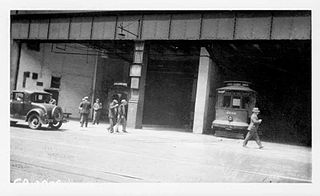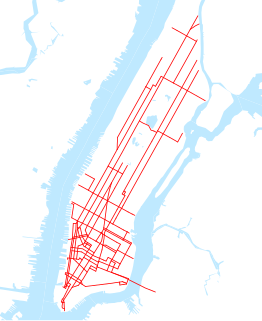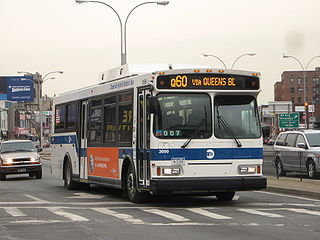Related Research Articles

New York State Railways was a subsidiary of the New York Central Railroad that controlled several large city streetcar and electric interurban systems in upstate New York. It included the city transit lines in Rochester, Syracuse, Utica, Oneida and Rome, plus various interurban lines connecting those cities. New York State Railways also held a 50% interest in the Schenectady Railway Company, but it remained a separate independent operation. The New York Central took control of the Rochester Railway Company, the Rochester and Eastern Rapid Railway and the Rochester and Sodus Bay Railway in 1905, and the Mohawk Valley Company was formed by the railroad to manage these new acquisitions. New York State Railways was formed in 1909 when the properties controlled by the Mohawk Valley Company were merged. In 1912 it added the Rochester and Suburban Railway, the Syracuse Rapid Transit Railway, the Oneida Railway, and the Utica and Mohawk Valley Railway. The New York Central Railroad was interested in acquiring these lines in an effort to control the competition and to gain control of the lucrative electric utility companies that were behind many of these streetcar and interurban railways. Ridership across the system dropped through the 1920s as operating costs continued to rise, coupled with competition from better highways and private automobile use. New York Central sold New York State Railways in 1928 to a consortium led by investor E. L. Phillips, who was looking to gain control of the upstate utilities. Phillips sold his stake to Associated Gas & Electric in 1929, and the new owners allowed the railway bonds to default. New York State Railways entered receivership on December 30, 1929. The company emerged from receivership in 1934, and local operations were sold off to new private operators between 1938 and 1948.

The Fifth Avenue Coach Company was a bus operator in Manhattan, The Bronx, Queens, and Westchester County, New York, providing public transit between 1896 and 1954 after which services were taken over by the New York City Omnibus Corporation. It succeeded the Fifth Avenue Transportation Company.

The Third Avenue Railway System (TARS), founded 1852, was a streetcar system serving the New York City boroughs of Manhattan and the Bronx along with lower Westchester County. For a brief period of time, TARS also operated the Steinway Lines in Long Island City.

The Lenox Avenue Line is a surface transit line on Lenox Avenue in Harlem, Manhattan, New York City, United States. The line was once operated separately, but later became the northern end of the Broadway and Columbus Avenue Line and Broadway and Lexington Avenue Line, now the M7 and M102 bus routes.

The Bx12 is a public transit line in New York City running along the 207th Street Crosstown Line, within the boroughs of Manhattan and the Bronx. The line runs along 207th Street in Upper Manhattan and along the continuous Fordham Road and Pelham Parkway in the Bronx.

The New York Railways Corporation was a railway company that operated street railways in Manhattan, New York City, United States between 1925 and 1936. During 1935/1936 it converted its remaining lines to bus routes which were operated by the New York City Omnibus Corporation, and now operated by the Manhattan and Bronx Surface Transit Operating Authority. The organization was the successor to the New York Railways Company which was in receivership.
The Central City Railway was chartered on April 19, 1859, and was the first street railway company in Syracuse, New York. It began operations in August 1860, as a horse-drawn rail. The road was discussed for many years before it was actually constructed as a link between the First Ward and Erie Canal at Salina Street. The train line commenced at South Salina Street opposite the Syracuse House and terminated in the First Ward.
The Syracuse, Eastwood Heights and DeWitt Railroad, an interurban rail in Syracuse, New York was established in 1859. This was one of the most important of the first lines and operated as a steam road. The company was awarded the operation rights for the Burnet Avenue route as well as the Burnet Street Car Company.
The Syracuse and Geddes Railway, a horse-drawn street trolley in Syracuse, New York, was chartered on July 10, 1863. The line ran from Syracuse to Geddes, a suburb. The route ran from Salina Street and Fayette Street to Hemlock, Bridge and Furnace Street.
The Fifth Ward Railroad was a horse-drawn street trolley line in Syracuse, New York, and was originally approved for construction by New York State in 1850; however, the rail was not chartered until 1867 and finally opened for business in 1868. The company merged with Syracuse Consolidated Street Railway in 1890, after an agreement was made that allowed the new company to lease the lines.
The Syracuse and Onondaga Railway, a horse-drawn city railway, was chartered on April 29, 1863, and opened on July 25, 1864, in Syracuse, New York. The line commenced in Downtown Syracuse at Washington Street and terminated at Oakwood Cemetery at Brighton Avenue where it connected with the Onondaga Valley Railroad. By 1890, the total length of the road was 2 miles (3.2 km).
The New Brighton and Onondaga Valley Railroad, a horse-drawn street trolley line, was chartered on May 5, 1869, in Syracuse, New York. The road was also known as the New Brighton and Onondaga Railroad.
The Seventh Ward Railroad, a street trolley line in Syracuse, New York, was established in 1886 and held the city railway franchise rights to East Fayette Street. The total length of the road was 3 miles (4.8 km). The route followed Fayette Street from Salina Street to Montgomery Street, Jefferson, Grape, Kennedy, Renwick Avenue with final destination Oakwood Cemetery.
The Eleventh Ward Railroad, a street trolley line in Syracuse, New York, was established in 1889 and held the city railway franchise rights to East Fayette Street. The line followed East Fayette Street to Montgomery Street and from there through Burt, Cortland Avenue, Midland Avenue, Colvin Street, Mulberry, Elizabeth, Baker Avenue and terminating on Kennedy street.
The Third Ward Railway, an electric street trolley line in Syracuse, New York, was established in 1886 and ran a distance of 4 miles (6.4 km) commencing in Park Avenue and terminating at Solvay Process Company in Solvay, a suburb. A second extension was open for business on July 4, 1889, when a branch was added from West Genesee Street to the shore of Onondaga Lake, known as "lake shore."
The Fourth Ward Railroad, a street trolley line in Syracuse, New York, was organized in 1887 and opened in 1888. The company was one of three different railways that were awarded operation franchise rights to run cars in James Street.
The Rochester Railway Company operated a streetcar transit system throughout the city of Rochester from 1890 until its acquisition by Rochester Transit Corp. in 1938. Formed by a group of Pittsburgh investors, the Rochester Railway Company purchased the Rochester City & Brighton Railroad in 1890, followed by a lease of the Rochester Electric Railway in 1894. The Rochester and Suburban Railway was leased in 1905, extending the system's reach to Irondequoit and Sea Breeze. Rochester Railways was acquired by the Mohawk Valley Company, a subsidiary of the New York Central Railroad set up to take control of electric railways in its territory. In 1909 the holdings of the Mohawk Valley Company were consolidated as the New York State Railways.

The Q60 bus route constitutes a public transit line running primarily along Queens Boulevard in Queens, New York City, extending from Jamaica into Midtown Manhattan. It is city-operated under the MTA Bus Company brand of MTA Regional Bus Operations.

The Williamsburg Bridge Trolley Terminal, also called the Essex Street Trolley Terminal or Delancey Street Trolley Terminal, was a trolley terminal located underground adjacent to the Essex Street subway station in the Lower East Side of Manhattan. Passenger trolley service operated through the terminal from 1908 until 1948 when trolley service over the Williamsburg Bridge ended. The station was constructed with balloon loops for turning around streetcars after they crossed over the Williamsburg Bridge to send them back to Brooklyn.

The Q65 bus route constitutes a public transit line in Queens, New York City. The south-to-north route runs primarily on 164th Street, operating between two major bus-subway hubs: Sutphin Boulevard–Archer Avenue station in Jamaica and Flushing–Main Street station in Flushing. It then extends north along College Point Boulevard to College Point at the north end of the borough. The route is city-operated under the MTA Bus Company brand of MTA Regional Bus Operations.
References
- ↑ Whipple, Fred H. Whipple's Electric, Gas and Street Railway Financial Reference Directory. Electronic Library, 2011. Retrieved July 5, 2011.
- ↑ "First Streetcars Operated Here in 1860". Syracuse Herald . Syracuse, New York. December 14, 1922.
- ↑ "Study for Bus Franchise Recalls Early Trolley Lines". Syracuse Herald-Journal . Syracuse, New York. May 23, 1940.
- ↑ Dwight Hall Bruce. Memorial history of Syracuse, N.Y., from its settlement to the present time. Electronic Library, 2011. Retrieved July 5, 2011.